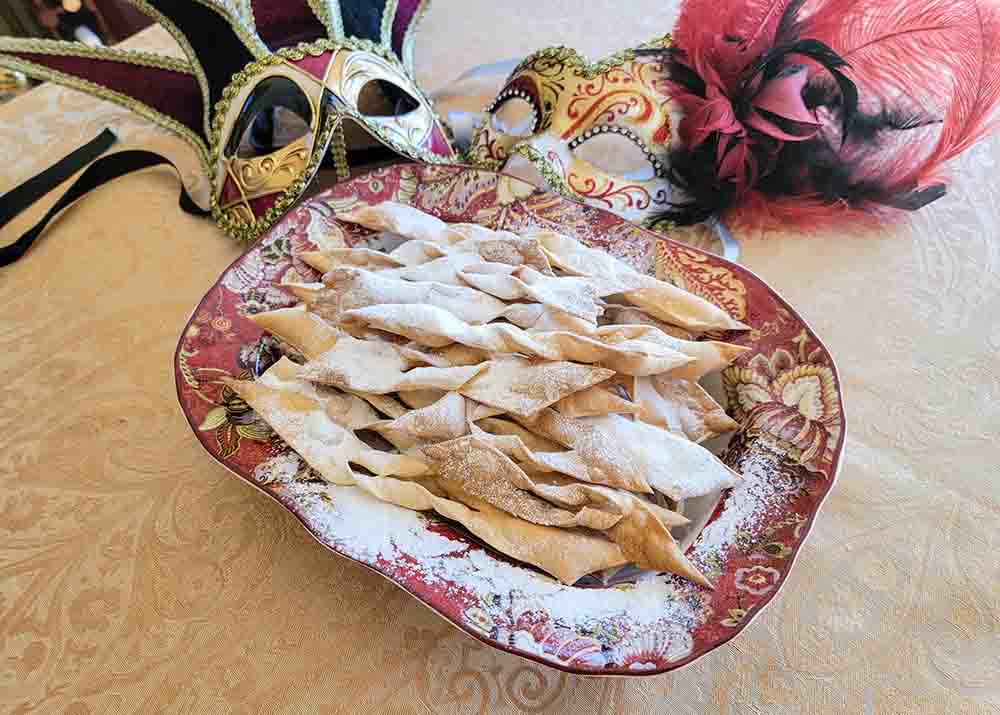
Homemade pączki (autor's photo, 2021)
Fat Thursday is a tradition in many countries. For example, in the Rhineland, Germany, Weiberfastnacht (Women's Carnival Night) is the day when women take over town halls, symbolically cutting off... the gentlemen's ties — in exchange for a kiss on the cheek. Giovedì grasso is also celebrated in Italy, and jueves lardero (also called Día de la Tortilla, or Tortilla Day) in Spain. In Poland, this day is celebrated rather sweetly, by eating mainly pączki and faworki (angel wings). This year, Fat Thursday falls on February 24.
Fat Thursday and Easter
The date of Fat Thursday depends on the date of Easter, and Easter is a movable holiday that occurs on different day each year. The exact date indirectly depends on the first day of Spring (usually March 21) and... the phase of the moon. Simply put, Easter is the first Sunday after the Full Moon that falls on — or after — the Spring Equinox, and if the Full Moon falls on a Sunday, then Easter falls on the following Sunday.
This year (2022), Easter Sunday is quite late, April 17. It is the day after the first full moon this spring, on Holy Saturday. So, going back in time, Ash Wednesday, which begins the 40-day Lent, is March 2 this year. The preceding Śledzik (Little Herring), or Tłusty Wtorek (Mardi Gras, Fat Tuesday), is March 1. The Thursday 6 days before that is, of course, Fat Thursday, this year occurring on February 24.
Fat Thursday and Carnival's End
The word "ostatki" (remnants), also known as "zapusty" (eng. shrovetide, refers to the last 3 days), refers to the last six days of the carnival that begin on Fat Thursday and end on Shrove Tuesday — called "little herring" (Śledzik) in Poland, and Mardi Gras in the USA (literally, Fat Tuesday in French). The next day — Ash Wednesday — marks the beginning of the Lent in anticipation of Easter.
The last of boisterous games and balls are organized before the coming period of culinary abstinence. Since Lent is an extended, forty-day-long fast for practicing Catholics, ostatki period is used as a time for overeating, indulging in general, and simply having fun. Traditionally, during this period of general dispensation, binge eating is allowed, as long as one does not burst.
Perhaps the most famous, largest and most spectacular carnival ball in the world is the Rio de Janeiro carnival parade, which begins on the last Friday before Ash Wednesday and lasts for five days until Wednesday morning. It is known for various excesses and is practically the national holiday of Brazil. On a slightly smaller scale, but also extremely loudly, traditional Mardi Gras is celebrated in New Orleans, in the United States, and — independently — in many other cities of the world, by way of organizing various festivals or street parades.
In Great Britain (as well as Australia, Canada and the United States) Mardi Gras day is also known as "Shrove Tuesday", or "Pancake Tuesday" and, as the name suggests, perhaps serves as an opportunity to eat pancakes. In Sweden and other northern European countries, the so-called semla, i.e. a kind of cream puff with creamy filling is consumed. In Poland, Fat Thursday begins the period of ostatki and is indispensably associated with pączki.
Polish pronounciation of Fat Thursday (Source: Wikimedia.org)
Fat Thursday versus Fat Tuesday
Since these two holidays have so similar names, many people confuse them. Both days are part of ostatki — the Thursday is opening them, and the Tuesday is the closing day — and the traditions connected with them are intertwined. However, these are two different days, and nothing prevents you from celebrating both, as well as all the days in between.
In Poland, Fat Tuesday is called "Śledzik" (eng. little herring), because this is when people say goodbye to carnival delicacies, welcoming the Lenten herring. Which does not prevent everyone from consuming pączki, faworki, all generously sprinkled with alcohol on this very day. After all, this is the last day of the carnival.
Pączki Day
Fat Thursday in Poland therefore means only one thing: pączki, and in large quantities! This is the first day of the indulgence interval before the long period of Lenten abstinence, so Poles try to enjoy their delicious pączki while they can still do it before fasting. According to tradition, pączki are not only a decadent delicacy, but also a way to ward off misfortune in the coming year.
Pączki (plural) — pronounciation in Polish (Source: Wikimedia.org)
For Polish-speaking people, this will come as no surprise, but we need to make it clear to our English-speaking readers: the word "pączki" is already in the plural and pronounced POHNCH-KEE. The written form of "paczki" is a funny-looking distortion for Poles that literally means "parcels" or "packages," just like the ones you would mail or ship. Not to mention that "paczkis", "ponchkies", or "ponchkees" are something even more ridiculous.
The singular form is "pączek" and is pronounced POHN-CHECK — but try and find someone, who could only eat one! In Poland, it is said that an average of 100 million pączki are eaten on Fat Thursday every year. That's about two and a half pączki for everyone living in the country.
Starting with Fat Thursday, people all over Poland are using the few days before Lent to really enjoy themselves. While most Poles work or go to school at least some of these days, it is not uncommon for bosses, colleagues, teachers, or classmates to bring pączki with them for everyone to enjoy. People also give one another pączki gifts, and visit one another to eat pączki together — this is truly a national holiday.

Faworki, or Angel Wings (author's own photo, 2022)
In addition to pączki, people often consume other fatty or sweet specialties, as well as alcohol. Angel wings, i.e. faworki (little favors) or chrust (brushwood, kindling), obligatorily sprinkled with powdered sugar, are also a very popular sweet treat on this day.
The History
The origins of Fat Thursday go back to the times of paganism. It was a day to celebrate the departure of winter and the arrival of spring. The feast was based on eating fatty foods, especially meats, and on drinking wine, and the snack consisted of pastries made of bread dough stuffed with bacon. Overeating on Fat Thursday symbolized the abundance and prosperity for the household, and a wager to not run out of food during the year.
Allegedly, even the Romans celebrated the so-called fat day in this way once a year.
Oskar Kolberg, a Polish ethnographer and folklorist, wrote in the mid-nineteenth century: "The feast necessarily included pączki, fried at home in lard, or angel wings, i.e. faworki, oblong shortcakes, fried in lard." [5]
What are pączki?
Pączek (singular) is one of the most iconic Polish dishes — known for a long time. It is said that Poles started producing and consuming pączki (plural) as early as in the Middle Ages, as a way to use up any remaining nutritious, albeit perishable ingredients (such as butter and eggs), before fasting. Indeed, "ostatki" translates as "remnants" when referring to the use of food scraps.
The custom of eating pączki in their sweet version appeared around the 16th century in Poland. In the past, pączki stuffed with pork fat, bacon and meat were eaten, while today, the most popular are those sweet ones, with icing or coated with powdered sugar, stuffed with cherries, jam, rose, or eggnog.
Today's pączki are balls of particularly rich yeast dough, deep-fried, traditionally filled with plum jam or rose petal confiture (although others are commonly used), and sprinkled with powdered sugar, or covered with icing. The basic ingredients are flour, butter, eggs, sugar and yeast, and the dough must be kneaded very well to get the best texture before frying, necessarily with lard. No additives or preservatives are used, so pączki don't keep well. Depending on the type and filling, each pączek is 330-460 calories, but you have to eat them while they are fresh. Bon Appetit!
It should be noted here that real Polish pączki have very little in common with American doughnuts, although in the United States, these notions are often confused. It is common to try to pass off the completely inferior American kind, as the real deal too often and easily equated to doughnuts, by using the unfortunate spelling "paczki" — please note the lack of a descender "ogonek" (little tail) below the letter a. Unfortunately, Krispy Kreme or Dunkin Donuts just don't cut it. The pączek never looks like a donut, there is never a hole in the center of a pączek, and when properly made, it is almost spherical, and has a clearly lighter horizontal stripe, from floating on the surface of hot fat during frying. If this lighter strip is not visible, then the pączek was not made properly.
You can buy pączki in Poland in virtually every bakery, grocery store, or supermarket, and not only on Fat Thursdays. On this very day, however, in larger cities like Warsaw or Krakow, some of the most popular bakeries will have hundreds of people lined up outside at the door and along the street. These are the scenes reminiscent of the communist era, when shopping was more like hunting and the lines were forming literally for everything.
Interview at the Confectionery Workshop in Warsaw (YouTube)
Of course, everyone can make pączki by themselves at home — it's not as difficult as it might seem (as you can see from my last year's photo at the beginning of the article), although it is somewhat time-consuming and requires precise control over the frying temperature.
For the "lazy" (or just busy) people from around Chicago, I personally recommend fresh, usually still hot, pączki from the Polish Pączki Cafe, on the corner of W Foster Ave. and Harlem Ave. (available all year round).

Polish Paczki Cafe in Chicago (author's photo)
Many an author wrote about the Polish sweet tradition of Fat Thursday. Here is an example:
A mountain of pączki, and behind that mountain,
greasy pancakes with jam,
behind the pancakes, a bowl of angel wings,
because today it is Shrovetide.
...
On a Fat Thursday you do have fun,
later sometimes your tummy hurts.— W. Broniewski
Regardless of whether you have a sweet tooth, a taste for alcohol, or are simply fascinated by the Polish culture, ostatki are a period that should not be missed! According to one of the old superstitions, if someone does not eat a single pączek on a fat Thursday — they will not be successful in the following year. So don't take any risks!









